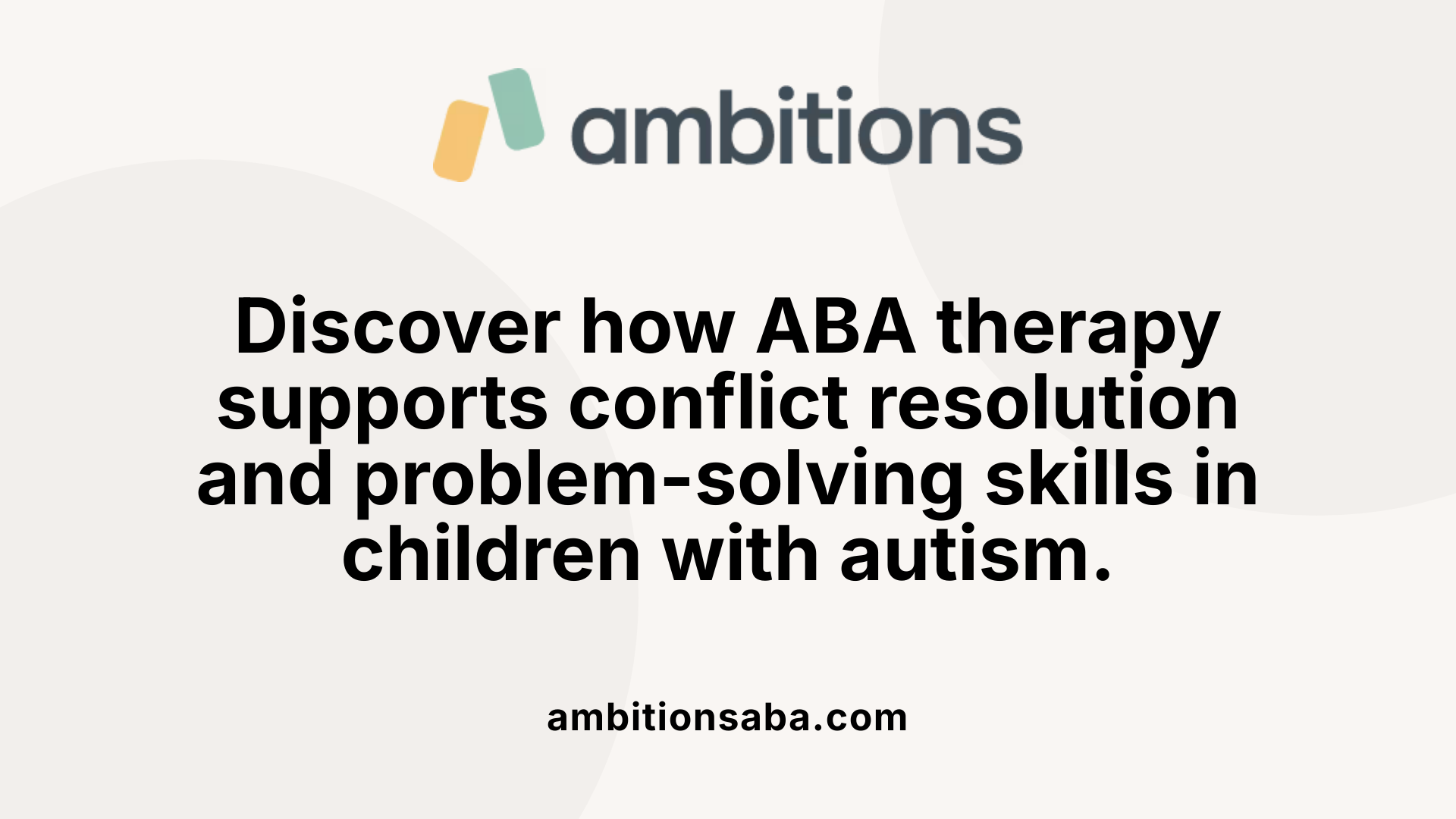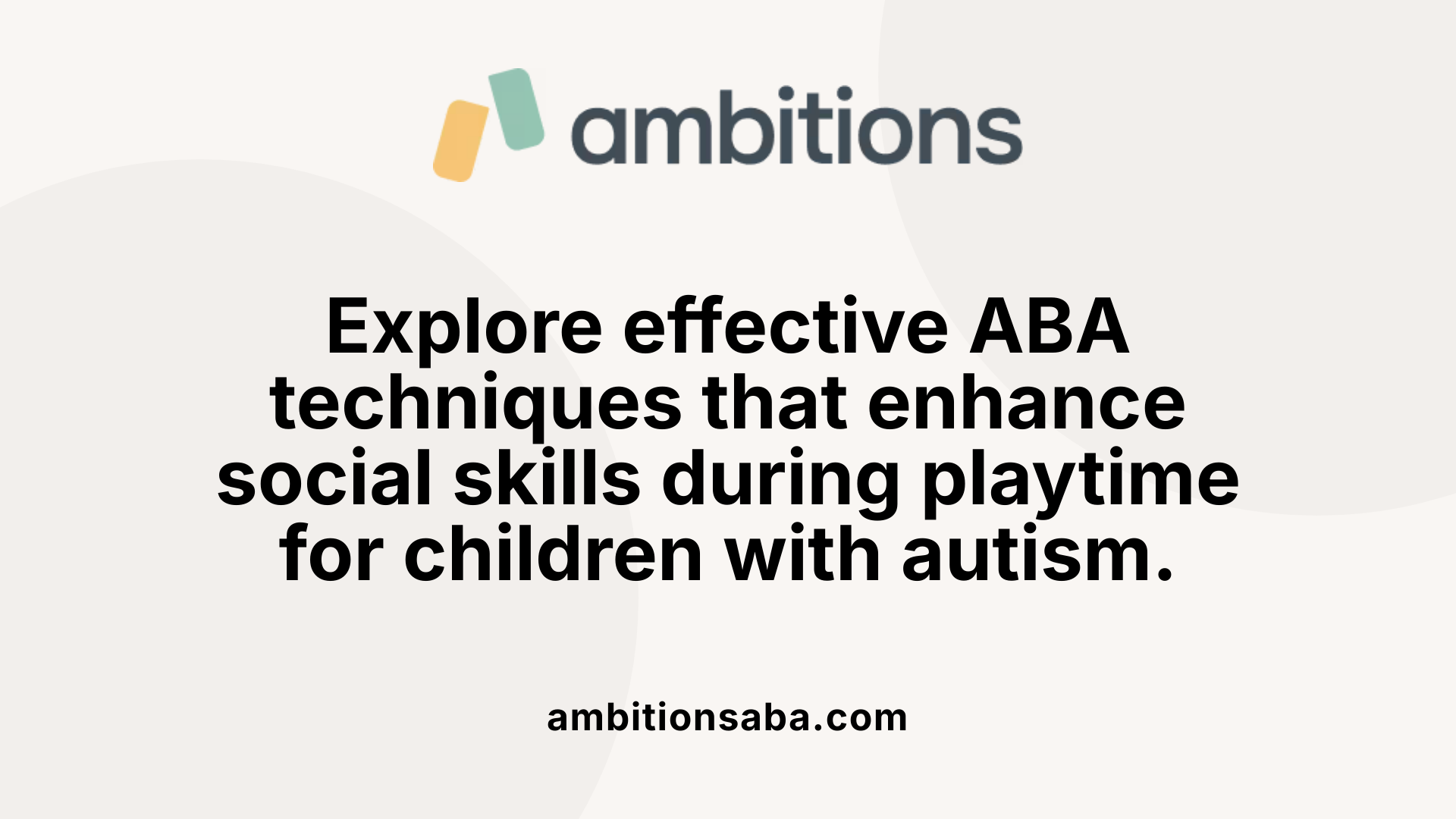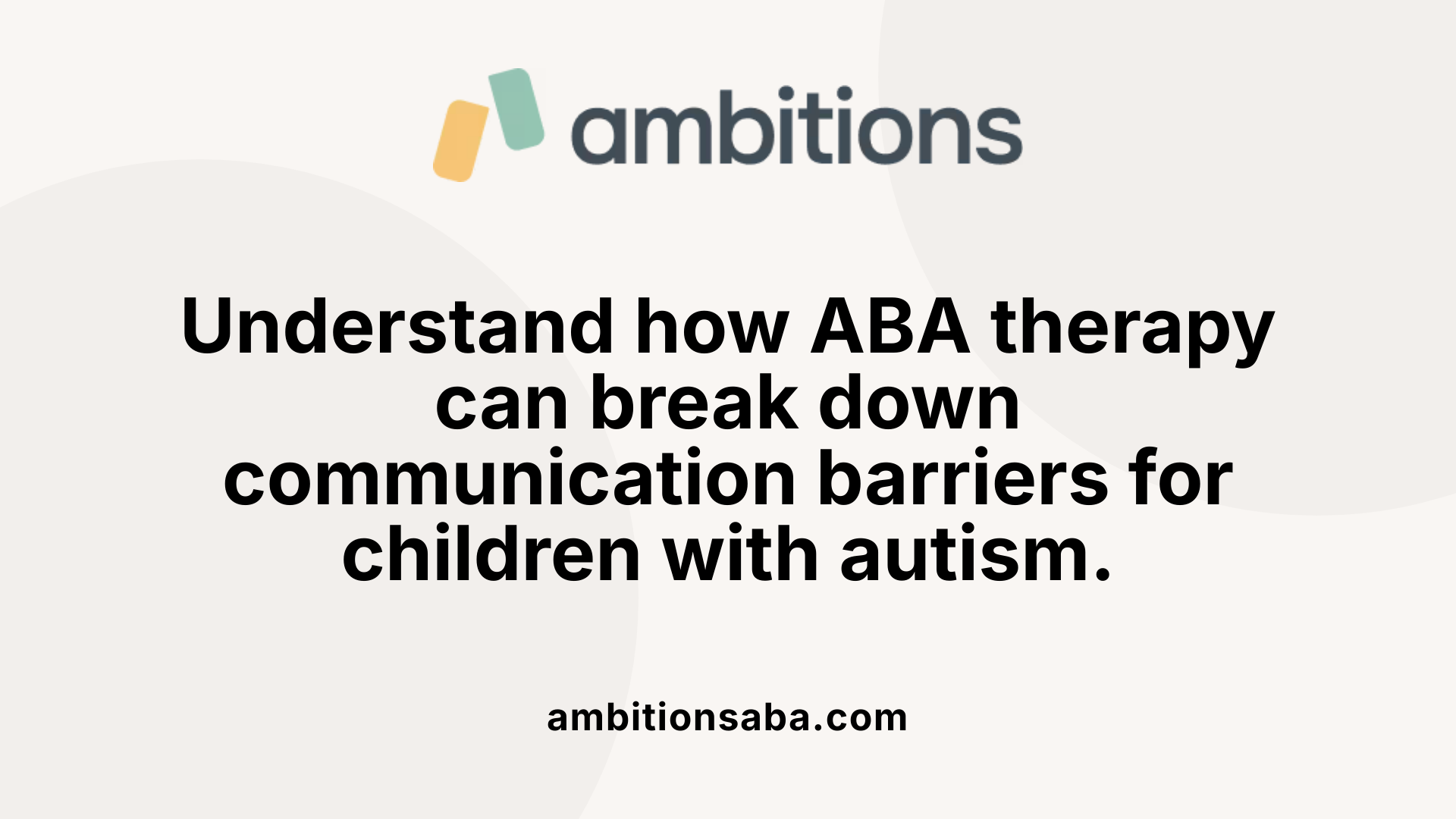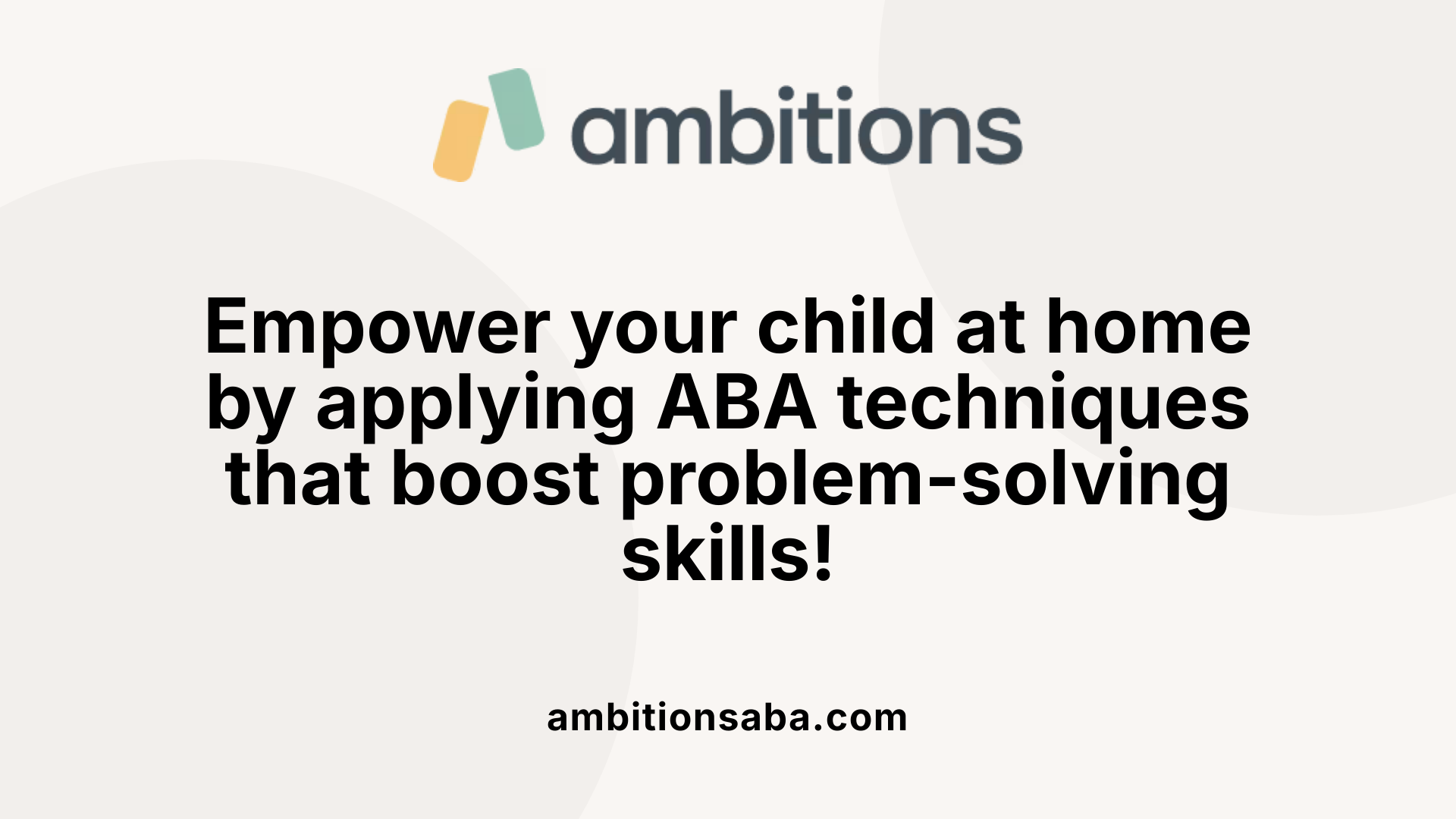Strengthening Families Through Effective Parenting Interventions
Introduction to ABA Therapy and Play
Applied Behavior Analysis (ABA) therapy is a highly regarded approach for improving behavioral outcomes in children with autism. This therapy, particularly when integrated with play, can significantly enhance conflict resolution and problem-solving skills. Understanding how ABA therapy is applied in playful settings provides key insights into its benefits for social interaction and skill development among children on the autism spectrum.
Understanding ABA Therapy's Role in Conflict Resolution

What is ABA therapy and how does it support conflict resolution and problem-solving skills in children with autism?
ABA therapy, or Applied Behavior Analysis, is a scientific approach designed to promote meaningful behavioral changes in children with autism. It supports conflict resolution and problem-solving by breaking down complex skills into manageable parts and providing positive reinforcement for desired behaviors.
One of the fundamental techniques used in ABA is structured play. This method emphasizes engaging children in activities like role-playing and games that foster cooperation. For instance, structured tasks not only develop communication skills but also teach children how to share, take turns, and manage disagreements. By learning these skills within a play context, children can practice conflict resolution in a low-pressure environment.
Moreover, ABA focuses on improving communication between autistic children and their neurotypical siblings. Techniques like verbal behavior strategies and picture exchange communication systems (PECS) enhance understanding and reduce frustrations often felt during social interactions.
Additionally, ABA therapy incorporates emotional regulation strategies that are vital for managing emotional reactions to conflicts. Techniques such as deep breathing exercises help children self-regulate, allowing for more thoughtful responses to disagreements.
To summarize the components:
| Component | Description | Benefits |
|---|---|---|
| Structured Play | Engaging children in cooperative games and role-playing | Enhances social skills and encourages negotiation |
| Communication Techniques | Utilizes PECS and verbal strategies | Reduces misunderstandings and builds bonds |
| Emotional Regulation Strategies | Teaches children self-regulation techniques | Prevents escalation during conflicts |
| Positive Reinforcement | Rewards desired social behaviors | Strengthens skills learned during play |
Through these methods, ABA therapy effectively supports children in developing conflict resolution and problem-solving abilities, forging stronger relationships with peers and siblings.
ABA Therapy Techniques in Play

How does ABA therapy improve social skills in children, particularly during play?
ABA therapy improves social skills in children, particularly during play, through structured techniques like role-playing, modeling, and reinforcement. These methods are designed to teach essential social behaviors such as sharing, taking turns, and understanding nonverbal cues in a supportive environment.
Techniques Used in ABA During Play
Various techniques are employed within ABA therapy sessions that focus on play skills. Some of these strategies include:
| Technique | Description | Purpose |
|---|---|---|
| Role-Playing | Simulating social interactions to practice desired behaviors | Enhances conflict resolution and negotiation |
| Modeling | Demonstrating appropriate social behavior for children to imitate | Teaches social skills and expectations |
| Positive Reinforcement | Rewarding desired behaviors during play | Encourages repetition and engagement |
Group sessions provide opportunities for peer interactions and cooperative play, which allow children to practice these skills in real-time.
Additionally, tools like social stories and visual aids are often utilized to help children grasp social expectations, navigate different scenarios, and reinforce learning.
Overall, ABA therapy emphasizes the generalization of skills learned, ensuring children can transfer what they've practiced in therapy to various real-world social contexts, all while fostering their social engagement and problem-solving abilities.
Enhancing Conflict Resolution: ABA Strategies

Can you describe specific ABA techniques used to enhance conflict resolution during play?
Specific Applied Behavior Analysis (ABA) techniques play a critical role in enhancing conflict resolution during play. For instance, therapists utilize:
- Modeling: Demonstrating appropriate responses to conflict can help children understand how to navigate disagreements.
- Prompting: Guides children to apply what they've learned in structured settings, reinforcing behavior in real-life scenarios.
- Positive Reinforcement: Encouraging desired behaviors strengthens children’s ability to respond appropriately during conflicts.
Structured activities such as role-playing scenarios, turn-taking games, and collaborative projects are particularly effective. These settings allow children to practice essential skills, including:
- Active Listening: Understanding others' perspectives helps in resolving disputes amicably.
- Empathy: Recognizing and responding to feelings fosters stronger relationships among peers.
- Negotiation: Children learn to articulate their needs and find mutually beneficial outcomes.
Moreover, emotional regulation techniques within ABA teach children to manage their reactions, facilitating calmer interactions. Incorporating Peer-Mediated Interventions (PMIs) provides additional opportunities for interaction, allowing children, particularly those on the autism spectrum, to apply their social skills in natural play environments.
Through consistent practice and reinforcement of these approaches, not only do conflict resolution skills improve, but overall social competence and engagement among children are enhanced, making play a more enjoyable experience for all participants.
Overcoming Communication Barriers with ABA

In what ways can ABA therapy address communication barriers in children with autism?
ABA therapy employs various augmentative and alternative communication (AAC) methods to enhance communication among children with autism. One prominent approach is the Picture Exchange Communication System (PECS), which allows non-verbal and minimally verbal children to express their needs through visual symbols.
Additionally, speech-generating devices (SGDs) and communication boards are used to facilitate effective communication. These tools are tailored to meet each child's unique needs, providing them with a means to convey their thoughts and desires.
Moreover, ABA emphasizes the significance of positive reinforcement, encouraging children to engage in communication behavior. This reinforcement not only supports the use of AAC tools but also fosters language development over time.
Intensive and long-term ABA interventions have demonstrated effectiveness in improving both expressive and receptive language skills. Functional communication assessments help identify the most suitable strategies for each child, enabling them to communicate better and engage socially with peers and family members.
By addressing these barriers, ABA therapy plays a crucial role in fostering meaningful interactions, making it easier for children with autism to navigate social environments.
Implementing ABA Techniques at Home

What strategies can be employed at home to implement ABA techniques for improving problem-solving skills in children?
Parents looking to enhance their children's problem-solving skills through ABA techniques can adopt several effective strategies in their home environment.
Structured Environment: Establishing a structured environment with clear expectations and consistent routines is vital. This helps children understand what is expected and enhances their ability to follow through with tasks.
Positive Reinforcement: Utilizing positive reinforcement is crucial. Parents should reward their children for demonstrating desirable problem-solving behaviors, such as trying to solve a puzzle independently or sharing toys with peers. This encourages children to repeat these positive behaviors.
Break Tasks Down: Complex tasks should be broken down into smaller, manageable steps. Parents can guide their children through each step, making the learning process less overwhelming and promoting confidence in their abilities.
Collaboration with Therapists: Working closely with ABA therapists can provide additional guidance tailored to each child’s specific needs. Parents can utilize data collection techniques recommended by therapists to assess their child's progress in problem-solving skills.
By implementing these strategies, parents can create a nurturing learning environment that significantly enhances their child's problem-solving abilities while using ABA techniques.
Structured Play as a Foundation for Problem-Solving
Can ABA therapy help with problem-solving skills?
Yes, ABA therapy aids in the development of problem-solving skills by incorporating structured play activities that engage children in critical thinking and reasoning tasks. This approach fosters essential abilities needed for effective conflict resolution during play and social interactions.
Structured play activities
ABA therapy utilizes structured play to create engaging learning opportunities tailored to individual needs. These activities include:
- Puzzles and Building Blocks: These promote reasoning and logic, enhancing children's ability to identify problems and explore solutions.
- Role-playing Games: Helps practice social skills and improve conflict resolution abilities in a safe environment.
- Collaborative Games: Encourage teamwork and negotiation skills, necessary for resolving disagreements amicably.
Problem-solving through play
Structured play enhances children's cognitive flexibility and creativity. By working through various problems during play, children learn to:
- Analyze situations: Observe details that are crucial for decision-making.
- Explore multiple solutions: Fostering critical thinking as they address challenges collaboratively.
- Develop emotional regulation strategies: Techniques such as deep breathing enable better management of emotions, essential during conflicts.
By integrating these aspects, ABA therapy not only promotes social interaction but also equips children with vital problem-solving abilities, enhancing their overall development during play.
The Significance of Emotional Regulation in Play
How does emotional regulation facilitate conflict resolution in play?
Emotional regulation plays a vital role in facilitating conflict resolution by helping children manage their reactions during play interactions. Children learn techniques through ABA therapy such as:
- Deep Breathing: Focusing on breath can help calm the mind and body during stressful moments.
- Calming Tools: Using tools like stress balls or fidget spinners provides physical outlets for excess energy.
These strategies enable children to maintain composure during conflicts, articulate their feelings effectively, and approach problem-solving with a clear and calm mindset. As a result, children can navigate disagreements more efficiently and engage in constructive solutions with peers.
Additionally, emotional regulation fosters the development of empathy, allowing children to understand the emotions of others, which is crucial for resolving conflicts amicably. By learning to manage their emotions, children become better equipped to handle disagreements, ensuring that their play experiences are positive and enriching.
Social Competence Through Applied ABA Strategies
How does ABA contribute to improving social competence?
ABA therapy plays a significant role in enhancing social competence among children, especially those on the autism spectrum. It achieves this by integrating structured, enjoyable play activities that emphasize interaction and cooperation.
Children engage in play that encourages them to understand and respond to social cues, such as
- Facial Expressions: Recognizing emotions in others.
- Body Language: Interpreting nonverbal signals during interactions.
- Turn-Taking: Learning to share the space and attention in group activities.
These experiences not only foster empathy and improve communication skills but also allow children to practice resolving conflicts and collaborating with their peers. As they receive consistent positive reinforcement within these structured environments, children develop greater confidence in their social interactions, which is essential for navigating complex social scenarios.
Integration into daily interactions
Applying ABA strategies in daily life enhances how children interact with their siblings and peers. For instance, through play exercises tailored to interests, children practice skills like negotiation and problem-solving, essential for resolving disagreements amicably. This integration ensures that skills learned in therapy carry over into real-life situations, promoting a smoother path to successful peer relationships.
The Impact of ABA Therapy on Development
ABA therapy provides a comprehensive framework for enhancing conflict resolution and problem-solving skills in children with autism, particularly through play. By focusing on structured, evidence-based interventions, ABA facilitates social development, improves communication, and reinforces positive behaviors. The integration of ABA techniques into daily play not only benefits children on the autism spectrum but also supports overall emotional and social growth, equipping them with essential skills for lifelong success in navigating interpersonal relationships.
References
- Encouraging Cooperative Play with ABA Therapy
- Supporting Sibling Relationships in Autism Families Using ABA
- ABA Therapy and Play: How Structured Play Supports Learning
- Play Therapy For Autism: What Parents Need to Know - Blue ABA
- ABA Therapy's Impact on Social Skills
- ABA Therapy for Problem-Solving and Critical Thinking Skills
- ABA PROGRAMS - DSP.Health
- [PDF] Supporting Child and Student Social, Emotional, Behavioral, and ...
- How Play Therapy Can Help Build Social Skills In Children
- Lawyer as Problem Solver Exercises - American Bar Association

